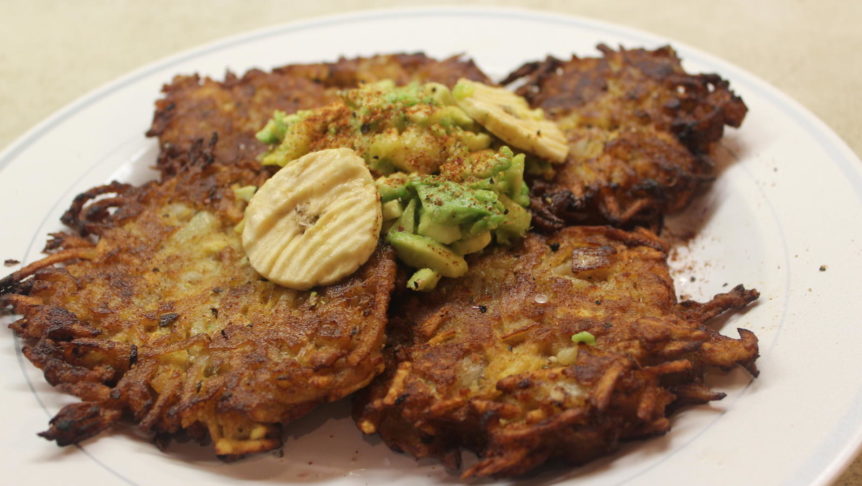I am often asked whether I feel more Cuban-American than Jewish, or vice versa, and it has always struck me as an odd question. That’s like asking whether I like my right eye better than my left. Sure, if you close one eye, you can still see, but the world looks so much better with both eyes open. That is sort of how I feel about my two cultures. On the surface, it may seem like my Cuban culture is in direct conflict with my Jewish one, particularly when it comes to the pork-friendly nature of Cuban cuisine and the dietary laws of the Jewish faith, but just like seeing the world with both eyes open, I feel most comfortable when my cultures work in conjunction with each other.
Fortunately, there is plenty of common ground between the two. Given the fact that both place a high priority on family and tradition, and get-togethers almost always revolve around food, my family has been blurring the cultural dividing lines for decades. This melting pot approach jumps into high gear around the holidays and other family gatherings. My “Jewban” family has been known to serve a creamy flan during Shavuot, a citrus and garlic-infused Cuban-style chicken for Shabbat, and minty Mojito-scented quinoa during Passover. These incredible dishes aside, nothing holds a candle to my family’s recipe for Ropa Vieja, Cuban comfort food at its very best.
Ropa Vieja, which literally translates to “old clothes,” or as my paternal grandmother would call them, “shmatas,” is the Cuban answer to a traditional Jewish brisket. Both use inexpensive cuts of meat that are slow-roasted until tender and falling apart, but Ropa Vieja takes it a step further, and actually calls for the chunks of meat to be shredded to resemble rags. This may seem like it would diminish the allure of the dish, but as Jewish brisket is usually reserved for the holiday table, a good Ropa Vieja is truly cause for celebration. Additionally, as it is important in the Jewish culture to pass our traditions from generation to generation, most Cuban families have had a recipe for Ropa Vieja for ages.
The recipe I feature originated with my Abuela (maternal grandmother), but was passed to me by my Tia Pipa (Aunt Felipa), both seriously tough culinary acts to follow. And while I have the added benefit of modern kitchen electrics like the slow-cooker, the spirit of the recipe remains the same. The perfume of a traditionally Cuban sofrito, made from garlic, onions, and sweet bell peppers, marries beautifully with the warm smokiness from the cumin. And while the brine-y capers that adorn the meat and add a splash of color may seem like a distinctly Mediterranean choice, they act as a nod to the migration of Spaniards that made their way to Cuba and the other Caribbean islands in days of old.
One bite may make you want to close your eyes and savor the moment, but I challenge you to resist the urge. See the world with both eyes open, and celebrate the diversity that makes Cuban-Jewish families unique.
Ropa Vieja, by Jennifer Stempel of TheCubanReuben.com
Serves: 6-8

Ingredients
• 5-7 lbs. Brisket, trimmed of most visible fat
• 2 onions, divided
• 6 cloves of garlic, divided
• 2 large red bell peppers, divided
• 2 bay leaves, divided
• 4 cups beef stock
• 3 tsp. Olive oil
• 1 Tbs dried oregano
• 1 Tbs ground cumin
• 1 14 oz can diced tomatoes
• 1 8 oz can tomato sauce
• 10 stuffed green olives, sliced in thin rounds
• 2 Tbs capers, plus 1 Tbs. of the brine.
• Salt and Pepper to taste
Instructions
1. Cut your brisket into 2-inch wide strips.
2. The night before you want to serve, add the brisket, 1 onion, roughly chopped, 2 whole cloves of garlic, ½ a bell pepper, 1 bay leaf, and beef stock to a slow-cooker, and set to cook on low for 6-7 hours.
3. Remove the beef and set aside. Once the beef is cool enough to be handled, use 2 forks to shred the beef.
4. Strain the cooking liquid, and reserve for later use in a medium bowl. Cover the bowl with plastic wrap, and refrigerate long enough for the fat to solidify on top (about 20-30 minutes). Skim the fat from the liquid.
5. Discard the rest of the contents from the slow cooker.
6. Meanwhile, finely dice the remainder of the onions and half of the remaining bell pepper. The rest of the bell pepper should be sliced in short, thin slices.
7. Mince the remaining garlic.
8. Heat a large pot (dutch oven style) over medium-high heat. Add olive oil.
9. Add the diced onions and both diced and sliced bell peppers, and cook for 5-10 minutes, or until onions become translucent. Add the garlic, and cook for 2 more minutes.
10. Add the shredded beef to the pot, as well as ½ of the now-skimmed stock, the oregano, the cumin, the diced tomatoes, and the tomato sauce. Stir to combine.
11. Lower the heat, cover the pot, and simmer for 30 minutes, or until liquid reduces and thickens a bit.
12. Add the olives, brine, and capers, and cook for 15 more minutes. Add salt and pepper to taste.
13. Leave simmering on low on the stove until ready to serve.
14. Serve with white rice.
To read more about Jennifer’s culinary adventures, check out her blog.






